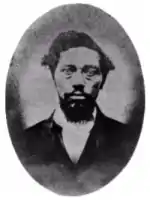Dangerfield Newby
Dangerfield Newby (1815 – October 17, 1859) was the oldest of John Brown's raiders, one of five black raiders, and the first of his men to die during Brown's raid on the federal armory in Harpers Ferry, Virginia.[1]
Dangerfield Newby | |
|---|---|
 Newby, c. 1850 | |
| Born | 1815 |
| Died | October 17, 1859 (aged 43–44) |
| Known for | Raid on Harpers Ferry |
Life
As was usual at the time, Newby's skin color was mentioned: he was "a tall and well built mulatto, aged about thirty years".[2]:81 Born into slavery in Fauquier County, Virginia, Newby's father was Henry Newby, a (white) landowner in Fauquier County. His mother was Elsey Newby, who was enslaved, owned not by Henry but by a neighbor, John Fox. Elsey and Henry lived together for many years and had several children; under Virginia law they could not marry. Dangerfield was their first child. Dangerfield Newby, his mother, and his siblings were later freed by his father when he moved them across the Ohio River into Bridgeport, Ohio. John Fox, who died in 1859, apparently did not attempt to reclaim Elsey, Dangerfield, or any of his siblings.[3]
Dangerfield's wife, Harriet Newby, was the property of Jesse Jennings, of Arlington or Warrenton, Virginia. She and their seven children remained enslaved in Virginia.[4] Newby had been unable to purchase their freedom; their owner raised the price after Newby had saved the $1,500 that had previously been agreed on. A letter found on his body revealed some of his motivation for joining John Brown and his raid on Harpers Ferry: he hoped to free them by force, since no other way had worked.
On 17 October 1859, the citizens of Harpers Ferry set to put down the raid. Harpers Ferry manufactured guns but the citizens had little ammunition, so during the assault on the raiders they fired anything they could fit into a gun barrel. One man was shooting six inch spikes from his rifle, one of which struck Newby in the throat, killing him instantly. His body remained in the street about 24 hours, "exposed to every indignity that could be heaped upon it by the excited populace."[5] The people of Harpers Ferry stabbed it repeatedly, and amputated his limbs. Hogs were later observed eating it.[6][2]:82 "The treatment the lifeless bodies of those wretched men received from some of the infuriated populace was far from creditable to the actors or to human nature in general."[2]:83 The Richmond Whig, however, describes Newby's body in the street thus: "No one seemed to notice him particularly, more than any other dead animal."[7]
Newby's body, and those of 7 of the 9 others killed, were thrown in a packing box which went in a pit, without ceremony, clergy, or marker. (The bodies of the other two were taken to Winchester Medical College for dissection by students.) In 1899 they were dug up and reburied in a single coffin on the former John Brown Farm in North Elba, New York.
Letter from Harriet Newby
The following letter was found on Dangerfield Newby's body after the failed Harpers Ferry raid:[8]
BRENTVILLE, August 16, 1859
Dear Husband.
I want you to buy me as soon as possible for if you do not get me somebody else will. The servants are very disagreeable. They do all that they can to set my mistress against me. Dear Husband you are not the trouble I see these last two years. It has been like a troubled dream to me. It is said that the Master is in want of monney. If so I know not what time he may sell me. Then all my bright hopes of the future are blasted. For there has been one bright hope to cheer me in all my troubles, that is to be with you. For if I thought I should never see you on this earth, life would have no charm for me. Do all you can for me which I have no doubt you will. I want to see you so much. The children are all well. The baby cannot walk yet. The baby can step around any thing by holding on to it, very much like Agnes. I must bring my letter to close as I have no news to write. You must write soon and say when you think you can come
Your affectionate Wife— HARRIET NEWBY
See also
References
- "John Brown's black raiders". Africans in America. WGBH; PBS Online. Archived from the original on 11 August 2020. Retrieved 20 August 2011.
- Barry, Joseph (1903). The Strange Story of Harpers Ferry. Martinsburg, West Virginia. Archived from the original on 2021-01-25. Retrieved 2021-01-25.
- Schwarz, Philip J. (2001). Migrants Against Slavery: Virginians and the Nation. University of Virginia Press. ISBN 0813920086.
- http://www.harpersferrywv.net/ghost_stories_of_harpers_ferry__.htm#Dangerfield Archived 2011-10-08 at the Wayback Machine Newby
- "Harper's Ferry Insurrection". National Era (Washington, D.C.). October 27, 1859 [October 18, 1859]. p. 4. Archived from the original on February 2, 2021. Retrieved December 1, 2020 – via newspapers.com.
- "Black America Web". Black America Web. Archived from the original on 15 November 2020. Retrieved 12 May 2016.
- "Incidents of the Second abattle". Richmond Whig. October 20, 1859. p. 1. Archived from the original on February 2, 2021. Retrieved January 27, 2021.
- "Dangerfield Newby's Letters from His Wife, Harriet" (PDF). Archived (PDF) from the original on 1 October 2011. Retrieved 20 August 2011.
External links
- The Kennedy Farmhouse John Brown's Provisional Army.
- PBS John Brown's black raiders
- A Ghostly Tour of Harpers Ferry Ghost Stories Of Harpers Ferry
- BlackAmericaWeb News Little-Known Black History
- Library of Virginia Dangerfield Newby (ca. 1820-1859). Culpeper County: Participant in John Brown's Raid